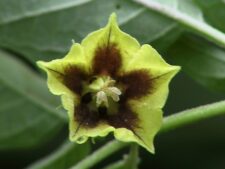
COMMON GROUND CHERRY
Physalis longifolia
NIGHTSHADE FAMILY (Solanaceae)
 Identification
Identification
- Flowering time - May, June, July, August, September
- Uncommon in disturbed sites at FF and NW
- Dangling, bell-shaped yellow flowers with dark base
- Dangling, lantern-shaped husks enclosing the seeds
- Hairless stems - See comments for comparison with similar Physalis species
This native perennial has a single, hairless stem, usually extensively branched above (C). Its alternate, lance-shaped leaves, up to 3 inches long have long stalks and smooth, undulating margins sometimes with shallow teeth (C). Individual, nodding, bell-shaped flowers dangle from slender stalks arising at the leaf axils (A). The pleated, pale yellow corolla is less than 1 inch wide and dark brown or purplish at the base, the site of 5 yellow anthers (B). The inflated 5-toothed calyx forms a papery lantern-like husk around the fruit, a berry with many yellowish seeds. Photo (D) shows the drooping flower surrounded by un-inflated, pointed green calyces which will eventually mature into an inflated lantern-like structure like that seen immediately to its right.
Found in diverse disturbed sites including open woods, fields, roadsides and some of our restored prairies where they flower from May through September. This plant which is uncommon at Fontenelle Forest and Neale Woods has been remarkably hard to find for one so common in our area.
Physalis is derived from the Greek word for bladder, reference to the lantern-like fruit husks. Gilmore indicates local Native Americans had names for the ground cherry which reflected their children’s practice of popping the bladders on their foreheads while at play.
Two other Physalis species with similar nodding flowers and fruits enclosed by an inflated bladder-like structure are quite common in eastern Nebraska, but have not been seen recently at our nature centers. Clammy Ground Cherry (Physalis heterophylla) has broader leaves and hairy leaves and stems. Virginia Ground Cherry (Physalis virginiana) should have hairs, at least on the stem, and is usually found in less disturbed habitats like native prairies and open woodlands.
The content of NatureSearch is provided by dedicated volunteer Naturalists of Fontenelle Forest who strive to provide the most accurate information available. Contributors of the images retain their copyrights. The point of contact for this page is: Neal Ratzlaff.



